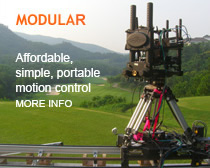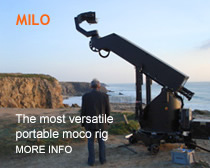- EQUIPMENT
- Motion Control Rigs
- Bolt
- Milo
- Long Arm Milo
- Modular Rig
- Friction Drive
- OUR WORK
- FEATURE FILM CREDITS
- IMPORT/EXPORT
- STAGE
CGI IMPORT
Importing a camera move from the Motion Control system is in itself relatively simple. Numerous scripts, plug-ins etc have been written and this task is usually the simplest. Once you have the move in the CG system, making it match the footage shot is an entirely different job and one this it often believed to just fall into place if only the data could come in. There is no substitute for being on set and seeing what is happening for making sure you have a fair chance of getting it all to work out. You can also make sure that the lens data is correctly recorded as well as ensuring that there is a bloop light somewhere in frame that will wind up on the transferred footage.
Line up for Import
For every series of shots from one track placement, you should insist that the Motion Control Operator be given time to record a line up move of some sort, and also insist that he gives you the data on set if possible. The line up move must be recorded on a object that makes sense. Here you will often be able to assist in making sure that a suitable object is chosen and knowing how the line up is done will assist in getting it all sorted out. Once you have the line up move into the CG package, you can see where it is in relation to the actual CG object that it is supposed to match. If you ONLY rotate about the vertical axis, and adjust XYZ translations until it lines up you will then have the exact values to apply to the Motion Control Move. Of course if the scale is wrong on the object, and it cannot be made to match, then you MUST find out why, not just scale to correct as there may be some other error that you are not accounting for, and this may throw the motion control move off.
Matching the images
So the move is imported and adjusted so that it is correctly lined up and offset, but the images do not match. What has gone wrong? Well the most common problem at this point has to do with focal length of lenses and the image size. Presumably, you have set the focal length of the lens correctly, but the aperture size really depends on HOW the film was transferred or telecined. A standard 35mm film gate full aperture is .981 by .735 inches. If the telecine cropped any of this, then that will affect how the image looks. If they have not centred the transfer then you can get a pan or tilt offset that will make it all look very strange. The secret here is to find out what was done and correct for the errors, not guess at it. Often in the CG package, you can set the gate size to however the transfer was done and fix that. A pan or tilt offset is another problem, and you should always insist that the image is transferred centred.
HD Cameras all seem to have different image sizes and the format you are recording will also sample different areas from the actual chip. It is VITAL to find out the size of the chip and the image scanning used to ensure your gate in CG matches what was really used. We warned, you will often be told is it a"2/3" chip. This is not accurate enough, you need actual mm or inch dimensions to make it work.
Once you have removed all the errors and accounted for any offsets, the images should match well. If they are right at the beginning and the end and drift badly in the middle, maybe there is a speed issue or you have not got the right start (bloop?) point. Otherwise if it is close but seems to drift a bit, then you have to determine if this is as good as it gets and track it in or if there is some other error that needs to be fixed. This is a matter of experience and judgment. The real world is never perfect, the rig's position is going to be very close to the reported position, but mechanical arms do bend under load and lenses often have some alignment or spherical aberrations. Do note that generally, lens aberrations will throw the image off more the further you get from the middle of the image. If the image matches well in the middle, then it may be just lens aberration.
Zoom Lenses
Please do not use a zoom lens unless you really have to. They do not model well and the nodal point moves when you zoom, so it adds a whole extra complexity. You have been warned! If you must use a zoom, then it makes sense to repeat the motion of the zoom lens only on a grid and use that to model the lens and also if you get a chance, run the move once without the zoom and use that for tracking then add the zoom after. This is often not possible in the time available, but if you get the chance.
Recent Projects
Snow White and The Huntsman
James Bond: Skyfall
Jack the Giant Killer
Hugo
Ed Sheeran "Small Bump"
The Muppets
Sherlock Holmes:
A Game of Shadows
Petronas Formula One
EbayMcLaren
BP
NatWest Bank
Lana Del Rey "Born to Die"
Barclaycard
Cartier
Rolex
Virgin Money
Pepsi
47 Ronin
Join our mailing list
Showreel
Available soon


